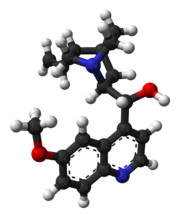Quinine
 |
|
 |
|
| Clinical data | |
|---|---|
| Pronunciation | US /ˈkwaɪnaɪn/, /kwɪˈniːn/ or UK /ˈkwɪniːn/ KWIN-een |
| Trade names | Qualaquin, Quinate, Quinbisul |
| AHFS/Drugs.com | Monograph |
| MedlinePlus | a682322 |
| License data | |
| Pregnancy category |
|
| Routes of administration |
By mouth, intramuscular, intravenous, rectal |
| ATC code | |
| Legal status | |
| Legal status | |
| Pharmacokinetic data | |
| Protein binding | 70–95% |
| Metabolism | Liver (mostly CYP3A4 and CYP2C19-mediated) |
| Biological half-life | 8–14 hours (adults), 6–12 hours (children) |
| Excretion | Kidney (20%) |
| Identifiers | |
|
|
| CAS Number | |
| PubChem CID | |
| IUPHAR/BPS | |
| DrugBank | |
| ChemSpider | |
| UNII | |
| KEGG | |
| ChEBI | |
| ChEMBL | |
| ECHA InfoCard | 100.004.550 |
| Chemical and physical data | |
| Formula | C20H24N2O2 |
| Molar mass | 324.42 g·mol−1 |
| 3D model (Jmol) | |
| Melting point | 177 °C (351 °F) |
|
|
|
|
|
|
|
Quinine is a medication used to treat malaria and babesiosis. This includes the treatment of malaria due to Plasmodium falciparum that is resistant to chloroquine when artesunate is not available. While used for restless legs syndrome, it is not recommended for this purpose due to the risk of side effects. It can be taken by mouth or used intravenously. Malaria resistant to quinine occurs in certain areas of the world. Some quantities are also used in tonic water and gives it its bitter taste.
Common side effects include headache, ringing in the ears, trouble seeing, and sweating. More severe side effects include deafness, low blood platelets, and an irregular heartbeat. Use can make one more prone to sunburn. While it is unclear if use during pregnancy causes harm to the baby, use to treat malaria during pregnancy is still recommended. How it works is not entirely clear. It is an alkaloid.
Quinine was first isolated in 1820 from the bark of a cinchona tree. Bark extracts have been used to treat malaria since at least 1632. It is on the World Health Organization's List of Essential Medicines, the most effective and safe medicines needed in a health system. The wholesale price in the developing world is about US$1.70 to $3.40 per course of treatment. In the United States a course of treatment is more than $200.
As of 2006, it is no longer recommended by the WHO (World Health Organization) as a first-line treatment for malaria, and it should be used only when artemisinins are not available. Quinine is also used to treat lupus and arthritis.
...
Wikipedia
